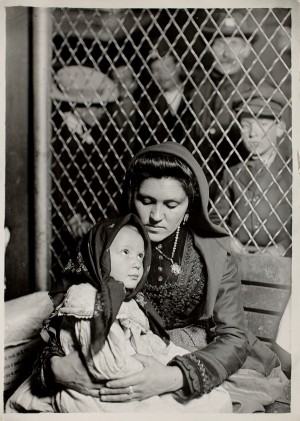Lewis Hine: Photographer As the People’s Prophet
Prophets come in many forms — the name itself conjures up the likes of the Biblical Moses, a fiery-tongued messenger for the Almighty, or as Shakespeare’s Macbeth put it so aptly, “a poor player…full of sound and fury, signifying nothing.” Lewis Hine (1874-1940) — perhaps the most influential American photographer of the early 20th century — calmly and quietly, camera in hand, went about his business as the people’s prophet. He pictured the plight of his fellow man, from Ellis Island immigrants and children toiling away in factories and tenement slums, to the Depression workers of President Roosevelt’s New Deal. He pictured hope, too, in the resilience of the people to visualize a better future. And that signified, unlike Macbeth’s player, a great deal.
The International Center of Photography’s current exhibit on Lewis Hine is really two shows in one. The first, and most comprehensive, concentrates on the photographer’s entire career; the second part gives a sampling from Hine’s work as chief photographer for the National Research Project, an arm of the Works Progress Administration initiated by Franklin D. Roosevelt in the 1930s. This portion is entitled The Future of America: Lewis Hine’s New Deal Photographs, and though a graphic example of workers wedded to their machine but not subject to its demands, it is only a part of this artist’s vision. In guest curator Judith Gutman’s words, this synthesis “as a just born industrial Siamese twin” activated the economy and became “the workplace’s new boss.” Glass, cotton, paper, shoes, sugar, watches, and brick making were just a few of the industries — 59 in all — that formed the ingredients of this mass production. And yes, Hine was enthusiastically on board for the transformation, demonstrating for Gutman his “embrace of form with content.”
One of the most iconic images illustrating this symbiosis in the photographer’s oeuvre is Mechanic at Steam Pump in Electric Power House from 1920. That image prefigures the workers Hine captured in the New Deal period but serves as a masterful example, nevertheless. A worker is depicted in profile, his back and torso curved inside the giant wheel of the steam pump, his fists clenched around his wrench. The man, as Hine presents him, serves as a visual echo of the wheel itself.
As for the New Deal photographs, they carry out the continuation of this theme but none more eloquently than this earlier example. Typical of those on exhibit is the Worker Pressing Rubber Bodies at the Paragon Rubber Company. This separate small gallery of black and white images is eye-catching with its walls painted a warm Tuscan orange to offset the sterile anonymity of the factory workers. Of particular historical interest is a picture of a single room dwelling for workers at the Highland Cotton Mills in High Point, North Carolina. In the background a woman sits at a vanity table, her back to the camera while her husband is pictured in a rocker in front of the bedstead, quietly reading. One single bulb in the center of the ceiling provides the only light. Though undoubtedly shot as an advertisement for company housing, it is a touching scene, reminiscent of the isolation often felt in Edward Hopper’s domestic paintings.
There’s no question that Hine’s depictions of on-the-job workers was emblematic of a new age dawning but the choice to accentuate this body of work, setting it apart from the larger exhibit, may cause some confusion among viewers. The strength inherent in the other aspects of the exhibit — Immigration, Tenements, Child Labor (his efforts on behalf of the National Child Labor Committee), Europe (Hine’s work documenting the Red Cross at the close of World War I), The Black Family, and the Empire State Building — provide powerful examples of Hine’s obsession not only with the “future of America” but with the individual. Curator Mason Klein in the Jewish Museum’s The Radical Camera exhibit catalogue from last year quoted Hine as saying, “I have always been more interested in persons than in people.”
One of Hine’s greatest talents was as a portraitist. With a resounding click of the shutter, he could convey in one person’s face all the joy and anguish it could hold. Such examples show his power not only as a humanitarian, but as an artist. The Ellis Island series has an obviously universal appeal in such images as Italian Madonna from 1905. There’s a beautiful stillness in the mother’s tender embrace of her child, surrounded by other male immigrant onlookers in the background. Hine became a passionate advocate for effective child labor laws, and as an instructor at the Ethical Culture School he served as a member of their National Child Labor Committee, documenting child workers from New York to Oklahoma. However challenging the daily lives were for these youngsters, whether a five-year-old Mississippi shrimp picker or scrappy but enthusiastic newsboys posing together in Midnight at the Brooklyn Bridge, Hine showed them with dignity and sometimes wisdom beyond their years. The young adolescent in Waiting for the Dispensary to Open, Hull House District, Chicago, 1910, is just such a subject. Barefoot, leg bandaged, he stares proudly at Hine’s lens. Hands clasping his jacket together, he takes his misfortune like a man.
(Article continued on next page)











